
Research Work Performed with the UCLA/CSU CEM
I. The cumulus ensemble model
The model used for performing the following research work is the UCLA/CSU CEM,
developed by S. Krueger and A. Arakawa at UCLA. It has been modified and
improved at CSU in the last few years.
CEMs are designed to simulate the formation of an ensemble of clouds
that developed simultaneously and randomly inside the model domain under a
given large-scale condition as if the CEM was situated with a grid box of a
large-scale numerical model. Thus, information on large-scale destabilizing
and moistening rates is imposed on CEM grid points uniformly in the horizontal.
The methods for imposing large-scale forcings are identical to those used in
Single-column Models (SCMs). See Randall et al. (1996) for further discussion.
The major difference between an SCM and a CEM is that cloud-scale circulations are
explicitly resolved in a CEM, but must be parameterized in an SCM. CEMs can
simulate bulk cloud properties such as cloud fraction and condensate mixing
ratio, which are not reliably observed. Moreover, the simulated variables
associated with the statistical properties of the clouds are internally
consistent. On the other hand, CEMs do not explicitly resolve every scale of
motions; they must have finer-scale parameterizations such as turbulence
closure, cloud microphysics and radiative transfer. CEMs have additional
limitations, for example, the periodic lateral-boundary conditions. These
limitations may or may not impact the simulated cloud-scale processes that
have to be parameterized in an SCM. Thus, CEMs can be used as a valuable or
complementary tool for SCMs to achieve the goal of improving cloud
parameterizations in GCMs or numerical weather prediction models
(Browning 1994; Randall et al. 1996).
A concise description of the UCLA/CSU CEM is as follows. A detailed description
can be found in Krueger (1988), Xu and Krueger (1991), Krueger et al. (1995),
and Xu and Randall (1995a).

Fig. 1: A concise description of the UCLA/CSU CEM.
References:
Browning, K. A., 1994:
GEWEX cloud system study (GCSS) science plan.
IGPO Publication Series, No. 11, International GEWEX Project Office, 84 pp.
Harshvardhan, R. Davies, D. A. Randall, and T. G. Corsetti, 1987:
A fast radiation parameterization for general circulation models. J. Geophys. Res.,
92, 1009-1016.
Kessler, E., 1969:
On the Distribution and Continuity of Water Substance in Atmospheric
Circulations. Meteor. Monogr. No. 32, Amer. Meteor. Soc., 84 pp.
Krueger, S. K., 1988:
Numerical simulation of tropical cumulus clouds
and their interaction with the subcloud layer. J. Atmos. Sci.,
45, 2221-2250.
Krueger, S. K., Q. Fu, K. N. Liou, and H.-N. Chin, 1995:
Improvements of an
ice-phase microphysics parameterization for use in numerical simulations of
tropical convection. J. Appl. Metero., 34, 281-287.
Lord, S. J., H. E. Willoughby, and J. M. Piotrowicz, 1984:
Role of a parameterized ice-phase microphysics in an axisymmetric, nonhyologic
tropical cyclone model. J. Atmos. Sci., 41, 2836-2848.
Randall, Xu, Somerville and Iacobellis, 1996:
Single-column models and
cloud ensemble models as links between observations and climate models.
Journal of Climate, 9, 1683-1697.
Xu and Krueger, 1991:
Evaluation of cloudiness parameterizations using a cumulus ensemble model.
Monthly Weather Review,
119, 342-367.
Xu and Randall 1995a:
Impact of interactive radiative transfer on the
macroscopic behavior of cumulus ensembles. Part I: Radiation parameterization
and sensitivity tests. J. Atmos. Sci., 52, 785-799.
II. Simulations of the July 1995 ARM IOP
The following describes some results from simulations of cumulus ensembles
at the Southern Great Plains during the July 1995 Intensive Observation Period
(IOP) of the Atmospheric Radiation Measurement (ARM) program. A detailed
comparison with available observations is made. In general, the CEM simulated
results agree reasonably well with the available observations from the July 1995 IOP.
The differences between simulations and observations are, however, much larger than
those obtained in tropical cases, especially those based on the GARP Atlantic Tropical
Experiment Phase III data. The radiative budgets and satellite-observed cloud amounts
are also compared with observations. Although the agreements are reasonably
good, some deficiencies of the model and inadequate accuracy of large-scale
advective tendencies can be clearly seen from the comparisons. Sensitivity simulations
are performed to address some of these uncertainties.
Main figures related to the simulations are presented in the following paragraphs
[see Xu and Randall (1999) for details].
a. The imposed large-scale forcings
The July 1995 IOP covers an 18-day period, starting from 0000 UTC on 18
July and ending at 2300 UTC on 4 August. Balloon-borne soundings of winds,
temperature and dewpoint temperature are obtained every 3 h from the cloud and
radiation testbed (CART) central facility located near Lamont, OK (36.61 N,
97.49 W) and from four boundary facilities, which form a rectangle of
approximate 300 km x 370km. Hourly wind data from 17 profilers surrounding
the CART array are also available as additional inputs for the constrained
variational objective analysis performed by M.-H. Zhang (see Zhang and Lin 1997).
This analysis provides a dynamically and thermodynamically consistent data set
in terms of vertically integrated quantities, with adjustments not far exceeding
the uncertainties of the original measurements.
All surface constraint variables are first gridded and then areally averaged.
Measurements from a variety of platforms such as the sondes, surface meteorological
observation system (SMOS), energy balance/Bowen ratio (EBBR), and Oklahoma (OK)
Mesonet and Kansas Mesonet were merged to produce the surface composites for the
constrained variational analysis. There are two versions of analyses performed
by M.-H. Zhang, one with the EBBR surface fluxes and the other with the SiB2
surface fluxes. In Figs. 2 and 3, only the SiB2 fluxes-based analysis is shown.
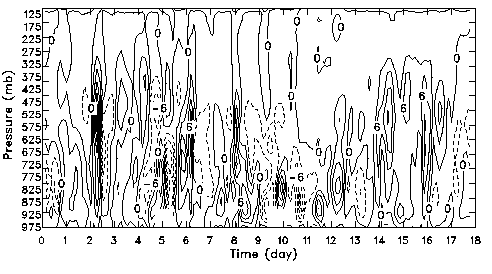
Fig. 2: Time-height cross section of the observed total advective
tendency of temperature for the July 1995 IOP. The contour interval is 5 K/day.
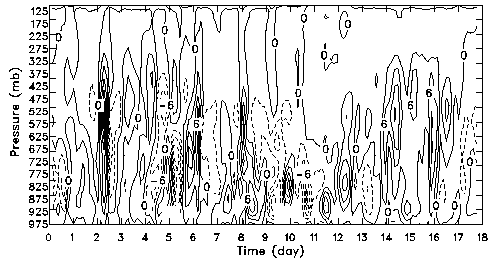
Fig. 3: Time-height cross section of the observed total advective
tendency of specific humidity for the July 1995 IOP. The contour interval is 6 g/kg/day.
b. Comparison with selected observations
A series of simulations have been performed with the CEM as a part of the ARM
SCM intercomparison study (Ghan et al. 1999), which compares the performance of
various SCMs and a two-dimensional (2-D) CEM with ARM IOP data sets by providing
a common set of forcing data and supporting data for running the SCMs and CEMs. The
goal of the intercomparison study is to identify the data requirements for the ARM
SCM research and to facilitate scientific advances by promoting collaborations
among ARM Science Team members through common activities; specifically, to
improve the representations of cloud formative/dissipative processes in
GCMs and their interactions with radiation.
The baseline simulation for the intercomparion study is D2, which uses the
total advective forcing shown in Figs. 2 and 3. Simulation D shown below is identical
to D2 except for using the EBBR fluxes-based analysis. The advective forcings are
only slightly different between the two versions of the analyses. The surface fluxes
prescribed in the model are, however, drastically different during daytime (Doran et al.
1998). In addition, the horizontal inhomogeneity of the surface fluxes is allowed
in the CEM.
The following figures (Figs. 4-8 and 10) indicates that the simulated results
compare favorably with the selected observations although the simulated temperature
and moisture biases are higher than those for tropical cases. The baseline simulation D2
is slightly superior than D in the time series of precipitable water and the
vertical profile of temperature (Fig. 10a).
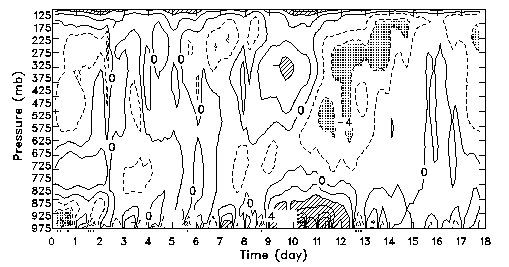
Fig. 4:
Time-height cross section of the simulated temperature differences from observations
for simulation D2. The contour interval is 2 K. Contours over 4 K are hatched. Contours
less than -4 K are dotted.

Fig. 5:
Time-height cross section of the simulated moisture differences from observations
for simulation D2. The contour interval is 1 g/kg. Contours over 3 g/kg are hatched.
Contours less than -3 g/kg are dotted.
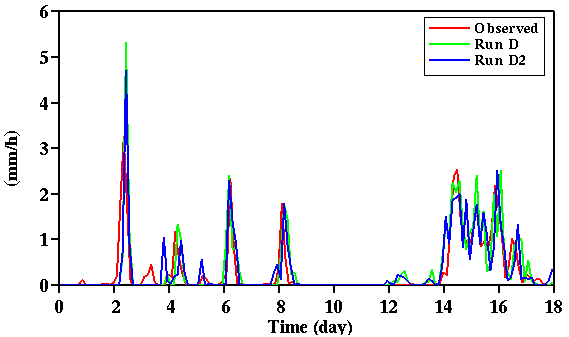
Fig. 6: Time sequences of the observed and simulated surface precipitation rates
for the July 1995 IOP. Simulations D and D2 adopt the total advective forcing method; D with
the EBBR fluxes and D2 with the SiB2 fluxes.

Fig. 7: Time sequences of the observed and simulated precipitable water (vertically
integrated water vapor mixing ratios) for the July 1995 IOP. Simulations D and D2 adopt the total
advective forcing method; D with the EBBR fluxes and D2 with the SiB2 fluxes.
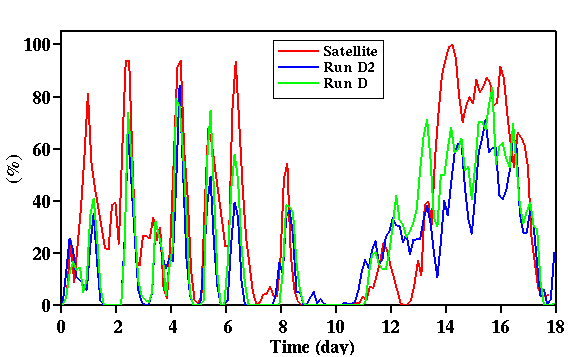
Fig. 8: Time sequences of the satellite-observed and simulated high-level cloud
amounts for the July 1995 IOP. Simulations D and D2 adopt the total
advective forcing method; D with the EBBR fluxes and D2 with the SiB2 fluxes.
c. EBBR vs. SiB2 fluxes
Figures 6, 7, 8, and 10 give a comparison between the two simulations with different
surface fluxes. Note that the imposed large-scale forcings in these two simulations are also
slightly different, as a consequence of the variational analysis. Most of the simulated
results between D and D2 are similar except for the precipitable water. The precipitable water
in D is generally higher in the first 14 days but lower in the last four days, compared with D2.
This is related to the large differences of the SiB2 and EBBR fluxes (Fig. 9). These differences
also impact the simulated temperature and moisture biases (Fig. 10).
Based upon the intercomparison study (Ghan et al. 1999), the differences in results
between EBBR and SiB2 fluxes are much smaller than those between the different forcing methods.
Another question yet to be answered is how much diferences are due to the surface fluxes
and how much differences are due to the changes in the large-scale forcings. The large
RMS temperature differences in the upper troposphere (Figs. 10a and 10b) suggests that the
changes in the large-scale forcings do impact the results.
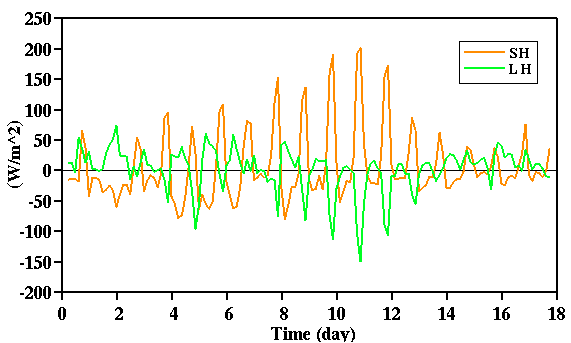
Fig. 9: Time sequence of the differences of sensible heat (SH) fluxes and latent
heat (LH) fluxes between SiB2 derived and EBBR observed data.
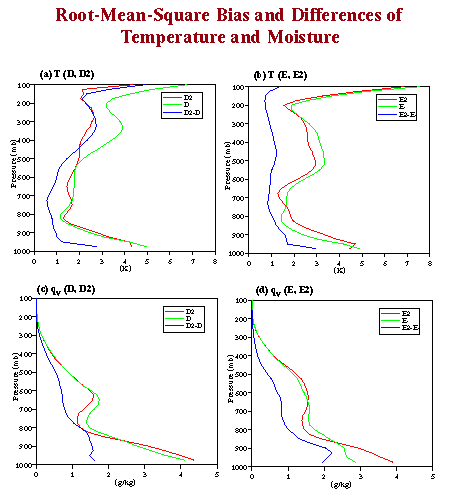
Fig. 10: Vertical profiles of root-mean-square (RMS) errors/bias from
the observations and the RMS differences between D and D2 (between E and E2) for temperature
(a and b) and specific humidity (c and d). Simulations E and E2 are respectively identical to D and D2
except with the vertical advective forcing method.
d. Vertical advective forcing vs. total advective forcing methods
There are at least three methods for imposing the large-scale advective forcings in
a CEM or an SCM;
i.e., the total advective forcing, the vertical flux forcing, and the nudging methods.
The vertical advective forcing method uses the large-scale vertical velocity and
horizontal temperature and moisture advections. Li et al. (1999) found that the
vertical flux forcing method produced smaller biases than the total advective forcing
method with the TOGA COARE data set, presumably due to the adjustment of vertical
thermodynamic structure to the imposed large-scale vertical velocity, especially in the
temperature profiles. Such a conclusion is further tested with the ARM data set here.
Simulations E and E2 shown in Fig. 10 are respectively identical to D and D2
except for adopting the vertical advective forcing method. Figure 11 and 12 show the
time-height cross sections of temperature and moisture differences between simulations
E2 and D2. The different methods do impact the results, i.e., in the vertical profiles
and temporal evolutions of temperature and moisture (in the lower troposphere only).
Which method produces better results? It depends upon the subperiods in the simulation.
Take the 18-day simulation as a whole, the answer can be found in Fig. 10 by judging
the magnitudes of the RMS biases. For the runs with the SiB2 fluxes, simulation
D2 is slightly better, while simulation E is slightly better for the runs with the
EBBR fluxes. Thus, Li et al.'s conclusion is dependent upon the quality of the given
data set. If the forcing data is very accurate, the total advective forcing method
is superior as far as the UCLA/CSU CEM is concerned.
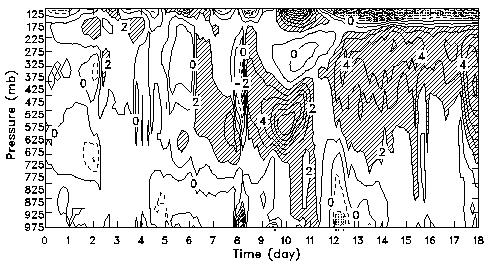
Fig. 11:
Time-height cross section of the temperature differences between simulations E2 and D2.
The contour interval is 2 K. Contours over 2 K are hatched. Contours less than -2 K
are dotted.
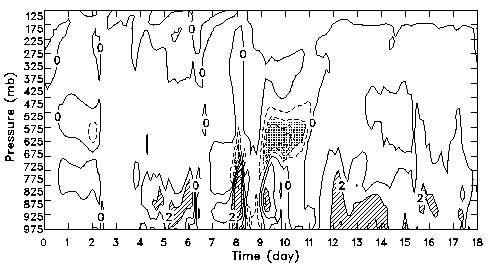
Fig. 12:
Time-height cross section of the moisture differences between simulations E2 and D2.
The contour interval is 1 g/kg. Contours over 2 g/kg are hatched.
Contours less than -2 g/kg are dotted.
e. LLNL vs. SUNY forcings
Two very different methods were used to analyze the July 1995 IOP data set. One was
performed at LLNL (Leach, Cederall et al. 1999) and the other was performed at SUNY (Zhang
and Li 1987). The latter has been adopted as the standard method for the ARM SCM intercomparison
study. Figure 13 shows the 18-day mean and standard deviation of the temperature and
specific humidity total advective tendencies as analyzed at LLNL and at SUNY. The LLNL
analysis only adopted the Barnes' (1964) objective method without the constraints used in
the variational analysis. The temperature tendency shows a good agreement between the
two analyses except for smaller cooling between 850 and 375 mb. On the other hand, the
moisture tendency of the LLNL analysis shows much larger temporal variations and noticeably
complicated vertical structures in both the mean and standard deviation profiles.
Another noticeable difference is the presence of much higher warming and drying rates
below 500 km. This could impact the simulated results.
The differences in the simulated results using the LLNL and SUNY forcings are
apparently larger than those due to forcing methods or the surface fluxes
shown above. The surface precipitation rate is only well reproduced at the end of the
IOP with the LLNL forcing (Fig. 14). The precipitable water is well underestimated during
the IOP (Fig. 15). This result is related to the much larger advective drying in the lower
troposphere of the LLNL forcing (Fig. 13b).
On the other hand, a surprising strength of the LLNL analysis is that more abundant
upper-level clouds are produced in spite of weak intensity of surface precipitation so that
the OLR agrees with satellite observations rather well (Fig. 16). This is related to the
similarity in the forcing data in the upper troposphere (Fig. 13). The lack of surface
precipitation is due to the fact that the drier atmosphere does not allow rainwater to reach
the ground due to evaporation.
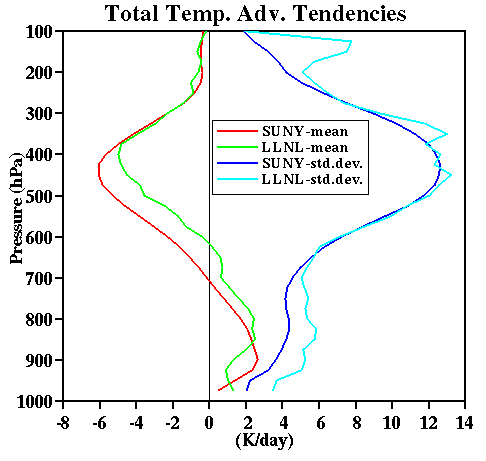
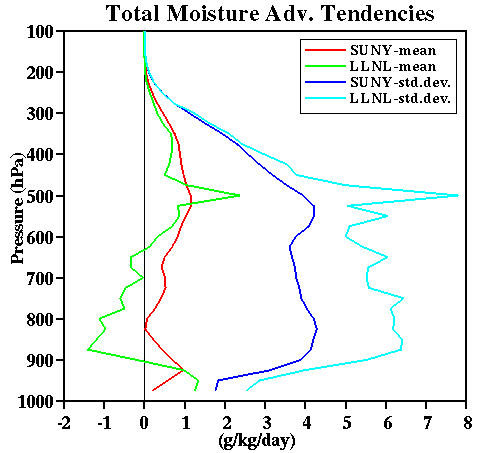
Fig. 13:
Vertical profiles of the mean and standard deviations of the large-scale advective tendencies
for temperature and specific humidity for both LLNL and SUNY data sets.

Fig. 14: Time sequence of the observed and simulated surface precipitation rates
for the July 1995 IOP. Simulations B and E adopt the vertical advective forcing method; B with
the LLNL data set and E with the SUNY (Zhang) forcing. Both were performed with the EBBR fluxes.
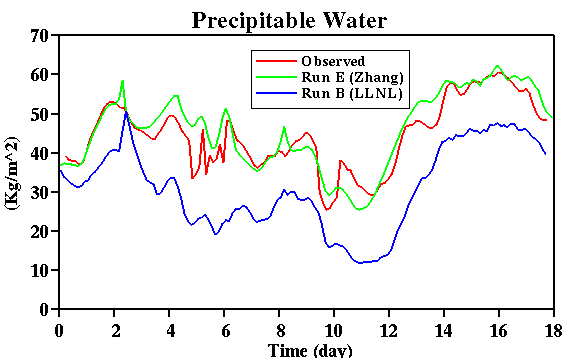
Fig. 15:
Time sequence of the observed and simulated precipitable water (vertically integrated water
vapor mixing ratios) for the July 1995 IOP. Simulations B and E adopt the vertical advective
forcing method; B with the LLNL data set and E with the SUNY (Zhang) forcing. Both were
performed with the EBBR fluxes.
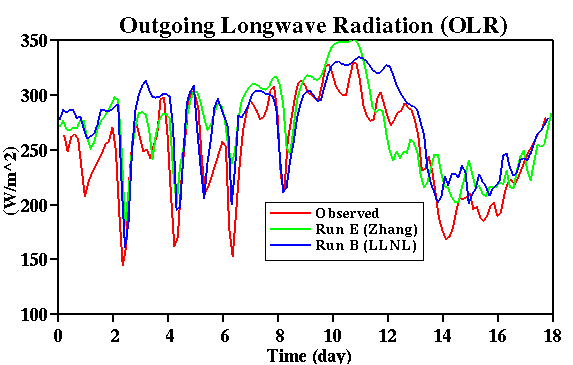
Fig. 16:
Time sequence of the observed and simulated outgoing longwave radiation (OLR) fluxes
for the July 1995 IOP. Simulations B and E adopt the vertical advective forcing method; B with
the LLNL data set and E with the SUNY (Zhang) forcing. Both were performed with the EBBR fluxes.
References:
Barnes, S. K., 1964:
A technique for maximizing details in numerical weather map analysis. J. Appl. Meteor.,
3, 396-409.
Doran, J. C., J. M. Hubbe, J. C. Liljegren, W. J. Shaw, G. J. Collatz, D. R. Cook, and R. L.
Hart, 1998.
A technique for determining the spatial and temporal distributions of
surface fluxes of heat and moisture over the southern great plains cloud and radiation
testbed. J. Geophys. Res., 103, 6109-6121.
Ghan, S., and 19 coauthors, 1999:
An intercomparison of single column model simulations of summertime midlatitude continental
convection. J. Geophys. Res., (to be submitted).
Leach, M., R. Cederwall, etc. 1999:
Objective anaylsis of ARM SCM IOP data sets (to be submitted).
Li, X., C.-H. Sui, K.-M. Lau, and M.-D. Chou, 1999:
Large-scale forcing and cloud-radiation interaction in the tropical deep convective regime.
J. Atmos. Sci., (in press).
Xu, and Randall, 1999:
Explicit simulation of midlatitude cumulus ensembles. Part I: Comparison with ARM data.
J. Atmos. Sci., (submitted).
Zhang, M. H., and J. L. Lin, 1997:
Constrained variational analysis of sounding data based on column-integrated budgets of mass,
heat, moisture, and momentum: Approach and application to ARM measurements.
J. Atmos. Sci., 54, 1503-1524.
III. Simulations of tropical oceanic convection
a. GATE Phase III
Description of GATE simulations and available CEM data for SCM validations
b. TOGA COARE
GCSS WG4 Intercomparison Study: Case 2
c. Sensitivity to initial condition and forcing data
The GATE simulation was performed with slightly altered initial conditions. An
ensemble average of three simulations was used to represent the simulated results.
From Figs. 17 and 18, both temperature and specific humidity deviations from the
ensemble average can be much higher than the initial purturbations. The
timing of the occurrence of mesoscale systems can be related to the large
amplitudes of the deviations, for example, around day 12 (12 September 1974).
Another point worth mentioning is that the temperature and specific humidity
deviations of the unperturbed run is not always the smallest among the three runs.
Thus, an ensemble of simulations, instead of a single simulation, are needed to
obtain the best results for a given large-scale forcing data set.
The TOGA COARE analysis performed at SUNY with the variational analysis is used
for studying the sensitivities to the initial condition and the large-scale
forcing. Three versions of the analysis are available, with slightly different
constrained data.
All simulations start from 18 Z December 18 1992, using the total advective forcing
method. For each version of the data set, three different initital conditions are used,
as in the GATE simulation. The results shown in Figs. 19, 20 (precipitable water) and 21
(surface precipitation rate) indicate that the results are more sensitive to the initial
conditions than to the imposed large-scale forcings. Remember that precipitable water
is a vertically integrated quantity. The differences between the purturbation runs are
as large as those between simulation and observation. Those between different versions
of the data set are smaller (Fig. 20). Again, this suggest that the ensemble simulations
are needed to obtain representative results for a given large-scale forcing data set.
The larger sensitivity to the initial condition is probably related to the coare
temporal resolution of the TOGA COARE data set (6 h vs. 3 h in GATE). That is, a
comparison of temporal variations from a single simulation with observations is
probably more misleading with the TOGA COARE data set than the GATE data set.
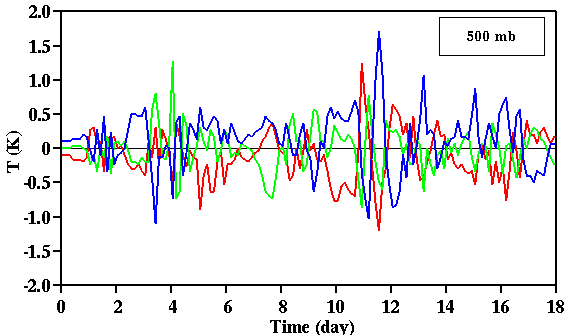
Fig. 17:
Time sequences of temperature deviations at 500 mb from the ensemble average for each
simulation in the ensemble using the GATE Phase III data.
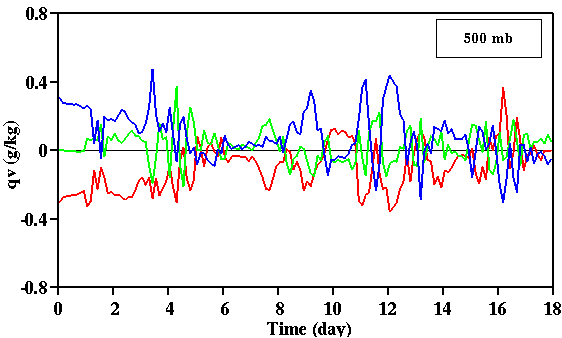
Fig. 18:
Time sequences of specific humidity deviations at 500 mb from the ensemble average for
each simulation in the ensemble using the GATE Phase III data.
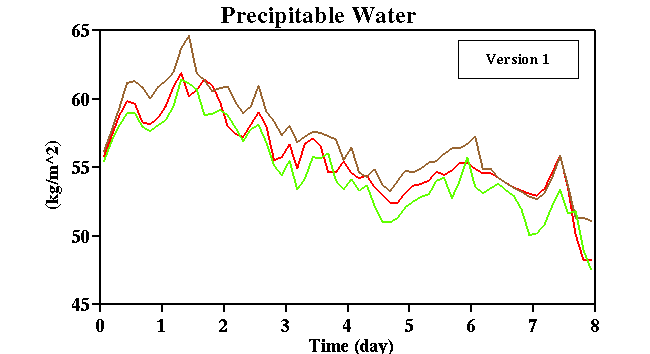
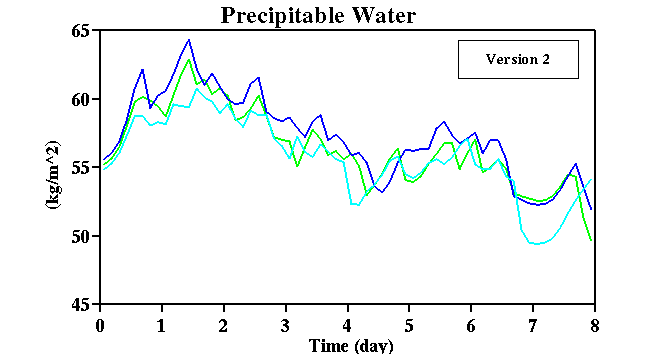
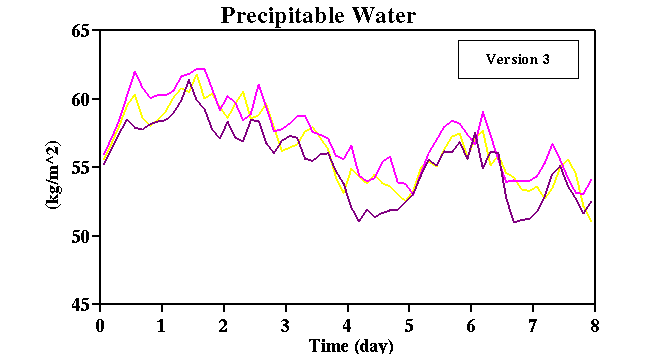
Fig. 19:
Time sequences of precipitable water for each perturbed simulation with three
different versions of the TOGA COARE data set, starting from 18Z, December 18 1992.
Three simulations were performed for each version of the forcing data.
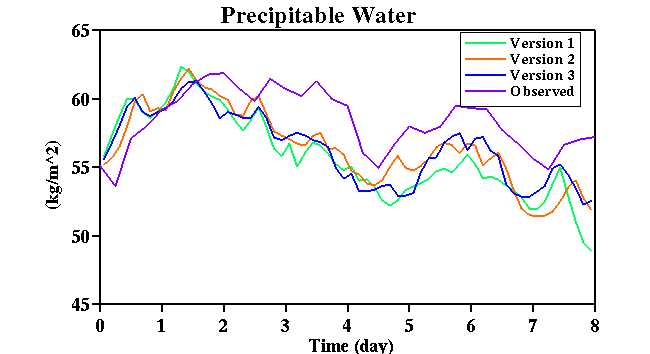
Fig. 20:
Time sequences of ensemble averaged precipitable water for each version of
the TOGA COARE data set, as well as that of the observation.
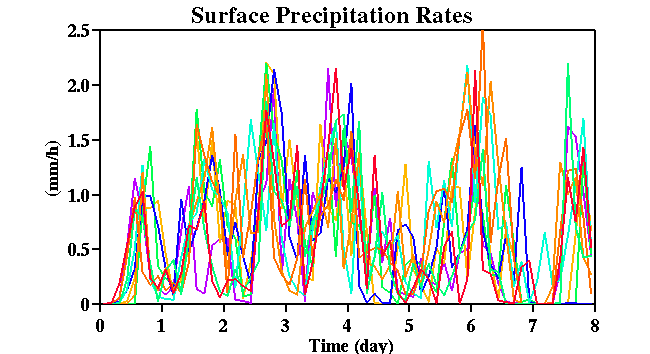
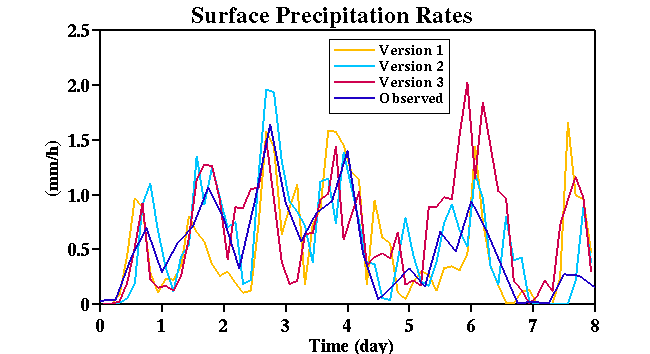
Fig. 21:
Time sequences of surface precipitation rates for all simulations and the ensemble average for
each version of the data set. The observed precipitation rate is also shown in the bottom panel.
IV. Comparison of statistical properties of midlatitude continetal with
tropical oceanic convection
Significant differences exist between the statistical properties of tropical
and midlatitude cumulus convection, especially in the vertical structures of
the cumulus mass fluxes, apparent heat source (Q1) and apparent moisture sink
(Q2). The strong variations of the subcloud-layer thermodynamic structure and the
surface fluxes in midlatitude continents have large impacts on the heat and
moisture budgets.
Figure 22 shows the mean profiles of the heat and moisture budget components
over 18-day for ARM (simulation D2) and GATE (simulation G) data set. Significant
differences between the two simulations appear in the condensation and
evaporation rates. The condensation rate is much smaller in midlatitudes than in
the Tropics, due to smaller amounts of shallow clouds. The evaporation rates
are more comparable, in spite of the drier midlatitude atmosphere, because
in-cloud evaporation in D2 is rather small.

Fig. 22a:
Vertical profiles of the latent heat release and the convergence of eddy heat fluxes
for the 18-day mean of simulation D2 (ARM) and G (GATE).

Fig. 22b:
Vertical profiles of the phase change rate and the convergence of eddy moisture fluxes
for the 18-day mean of simulations D2 (ARM) and G (GATE).
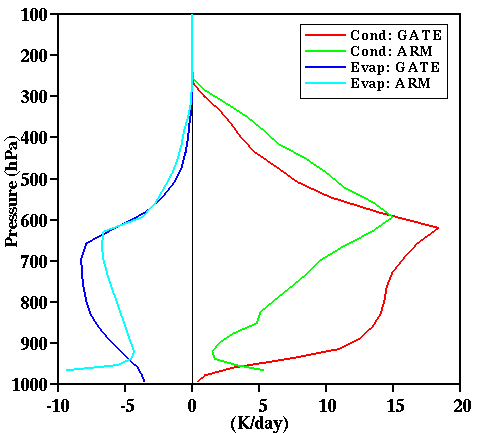
Fig. 22c:
Vertical profiles of the condensation and evaporation rates
for the 18-day mean of simulations D2 (ARM) and G (GATE).
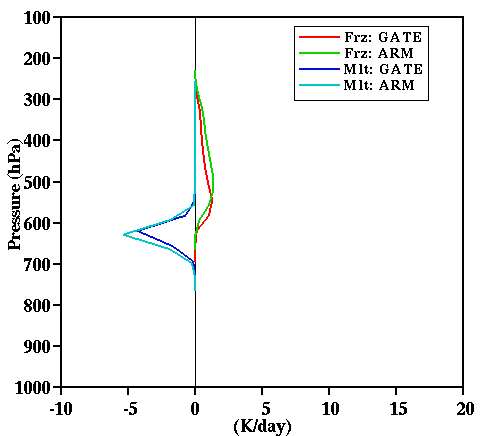
Fig. 22d:
Vertical profiles of the freezing and melting rates
for the 18-day mean of simulations D2 (ARM) and G (GATE).
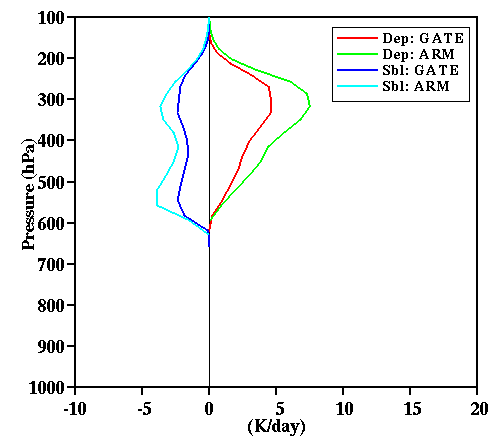
Fig. 22d:
Vertical profiles of the deposition and sublimation rates
for the 18-day mean of simulations D2 (ARM) and G (GATE).
Another type of comparison between midlatitude continental and tropical oceanic
convection is performed with the draft statistics approach as in aircraft meansurement
studies (LeMone and Zipser 1980; Jorgensen et al. 1985; Jorgensen and LeMone 1989;
Lucas et al. 1994; Wei et al. 1998). Aircraft observations of cumulus drafts revealed
the statistical behavior of updraft and downdraft vertical velocity. Some recent
observations also provided some information on the buoyancy of updrafts and downdrafts.
The sign of buoyancy is important for determining whether or not the updraft
(downdraft) is accelerating or decelerating. Observations of Jorgensen and LeMone
(1989), Lucas et al. (1994) and Wei et al. (1998) showed that downdrafts with positive
buoyancy and updrafts with negative buoyancy commonly occur, suggesting that decelerating
drafts occur almost as commonly as accelerating drafts.
Draft statistics from cloud-resolving simulations of tropical and midlatitude cumulus
convection are examined, following the procedure used in observations. Only the drafts with
absolute vertical velocities exceeding 1 m/s are included in the statistics. Statistics of
vertical velocity, buoyancy with/without loading effects, liquid static energy, total water
mixing ratio, condensate mixing ratio are provided.
In general, we find that the medium
values of updraft/downdraft strengths and other properties show the greatest similarity
between tropical and midlatitude cumulus convection. The strongest 10% of midlatitude drafts
are different from their counterparts in the Tropics (Fig. 23), with much stronger downdrafts
and updrafts in the midlatitudes. The greatest differences in the statistics of thermodynamic
properties of midlatitude and tropical cumulus convection occur in the lower troposphere,
due to the much drier environments of the continental convection (Figs. 23, 24 and 25).
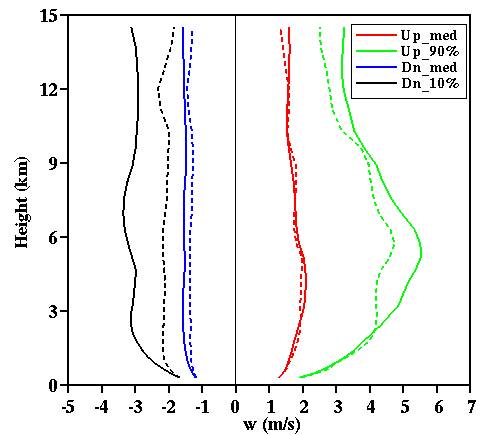
Fig. 23:
Vertical profiles of the medium (50 percentile) and 90 percentile of updraft and downdraft
vertical velocity. Solid lines are for the ARM simulations and the dashed lines for the GATE
simulations.

Fig. 24:
Vertical profiles of the medium (50 percentile), 10 percentile and 90 percentile of updraft
and downdraft buoyancy for both ARM and GATE simulations.

Fig. 24:
Vertical profiles of the medium (50 percentile), 10 percentile and 90 percentile of updraft
and downdraft moist static energy for both ARM and GATE simulations.
References:
Jorgensen, D. P., and M. A. LeMone, 1989:
Vertical velocity characteristics of
oceanic convection. J. Atmos. Sci., 46, 621-640.
Jorgensen, D. P., E. J. Zipser, and M. A. LeMone, 1985:
Vertical motions in internse hurricanes. J. Atmos. Sci., 42, 839-856.
LeMone, M. A., and E. J. Zipser, 1980:
Cumulonimbus vertical velocity events
in GATE. Part I: Diameter, intensity and mass flux. J. Atmos. Sci., 37,
2444-2457.
Lucas, C., E. J. Zipser, and M. A. LeMone, 1994:
Vertical velocity off Tropical Australia. J. Atmos. Sci., 51, 3183-3193.
Wei, D., A. M. Blyth, and D. J. Raymond, 1998:
Buoyancy of convective clouds in TOGA COARE.
J. Atmos. Sci., 55, 3381-3391.
V. Radiative-convective equilibrium simulations
The details of this type of simulations were given at Xu and Randall (1999).
VI. Detailed analysis of a composite easterly wave

































